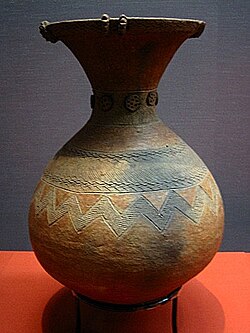| Part of a series on the |
| History of Japan |
|---|
 |
The Yayoi period (弥生時代, Yayoi jidai) started in the late Neolithic period in Japan, continued through the Bronze Age, and towards its end crossed into the Iron Age.[1]
Since the 1980s, scholars have argued that a period previously classified as a transition from the Jōmon period should be reclassified as Early Yayoi.[2] The date of the beginning of this transition is controversial, with estimates ranging from the 10th to the 3rd centuries BC.[1][3]
The period is named after the neighbourhood of Tokyo where archaeologists first uncovered artifacts and features from that era in the late 19th century. Distinguishing characteristics of the Yayoi period include the appearance of new Yayoi pottery styles, improved carpentry and architecture, and the start of an intensive rice agriculture in paddy fields.[4] A hierarchical social class structure dates from this period and has its origin in China. Techniques in metallurgy based on the use of bronze and iron were also introduced from China via Korea to Japan in this period.[5]
The Yayoi followed the Jōmon period and Yayoi culture flourished in a geographic area from southern Kyūshū to northern Honshū. Archaeological evidence supports the idea that during this time, an influx of farmers (Yayoi people) from the Korean Peninsula to Japan overwhelmed and mixed with the native predominantly hunter-gatherer population (Jōmon).
- ^ a b Shōda, Shinya (2007). "A Comment on the Yayoi Period Dating Controversy". Bulletin of the Society for East Asian Archaeology. 1.
- ^ Habu 2004, p. 258.
- ^ Mizoguchi, Koji (2013). The Archaeology of Japan: From the Earliest Rice Farming Villages to the Rise of the State. Cambridge University Press. pp. 35–36. ISBN 978-0-521-88490-7.
- ^ Seike, Kiyoshi (1977). The art of Japanese joinery. Yuriko Yobuko, Rebecca M. Davis (1st ed.). New York: J. Weatherhill. p. 8. ISBN 0-8348-1516-8. OCLC 3071841.
- ^ Farris, William Wayne (1996). "Ancient Japan's Korean Connection". Korean Studies. 20 (1): 1–22. doi:10.1353/ks.1996.0015. JSTOR 23719600. S2CID 162644598.